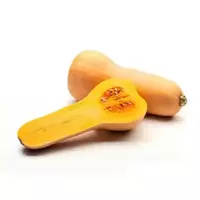Butternate pumpkin

Among all plants in the family Pumpkin pumpkin butternate or otherwise Waltham Butternut Squash is considered the American champion for its taste. Thus, a butternate pumpkin called Waltham was bred in 1960 at an agricultural experimental station in Massachusetts as a result of crossing butternut squash with wild representatives of African lands.
As it turned out, butternate pumpkin is an ultra-mature species (from the moment of germination to the time of collection of mature fruits takes no more than ninety-five days), which is widely known and cultivated in Australia, Europe, Africa, Asia, America. Butternate pumpkin is an important food source in all five continents.
Such a popular butternut pumpkin makes its magnificent gastronomic qualities. The sweet orange flesh of this vegetable has a subtle nutty flavor and has a dense, buttery texture. At the same time, the characteristic property of the butternate pumpkin is its ability to be stored for about a year at room temperature.
We can say that butternate pumpkin appeared in European countries relatively recently, and even in the UK it is still considered a novelty. However, this cannot be said about Argentina - it is from this country that the fruits of the butternat pumpkin are exported around the globe.
The butternate pumpkin plant itself grows powerful and long-woven, while the number of fruits, the average weight of which varies from 500 grams to one kilogram, is quite large - up to thirty per plant. Nevertheless, it is advised to remove the fruits in a timely manner due to the fact that when the seeds ripen in them, the growth of the rest is delayed. It is not recommended to remove fruits in the milky stage of ripeness, since they will not be able to mature.
Interestingly, some farmers (not very knowledgeable) often confuse butternat pumpkin with courgettes due to its small size, but the fruits are completely different on the cut. Butternate pumpkin is distinguished by a rather thick straight "neck" with a so-called "bulb" at the end, in which there is a small container with seeds. By the way, the orange color of the pulp determines the beneficial properties of butternate pumpkin, which is a rich source of antioxidants.
It is easy to guess that there are an unimaginably large number of recipes for which you can prepare dishes from butternat pumpkin. Around the world, it is used to make vegetable, cereal, meat and pasta dishes, as well as sauces, mash and soups. The fruits are widely used in stuffing. And on the basis of delicate fruits, puddings, cakes, cakes and candied fruits are often made. Finally, butternate pumpkin is simply boiled or fried in oil - slices with a light ruddy crust practically melt in the mouth.
45 kCal butternate pumpkins
Energy value of butternate pumpkin (Ratio of proteins, fats, carbohydrates - ju):
Proteins: 1 g (~ 4 kCal)
Fats: 0.1 g (~ 1 kCal)
Carbohydrates: 9.69 g (~ 39 kCal)
Energy ratio (bj | y): 9% | 2% | 86%
 Español
Español Français
Français Português
Português Русский
Русский 简体中文
简体中文 繁體中文
繁體中文 日本語
日本語 한국어
한국어 العربية
العربية Türkçe
Türkçe Қазақ
Қазақ Deutsch
Deutsch Italiano
Italiano Українська
Українська
